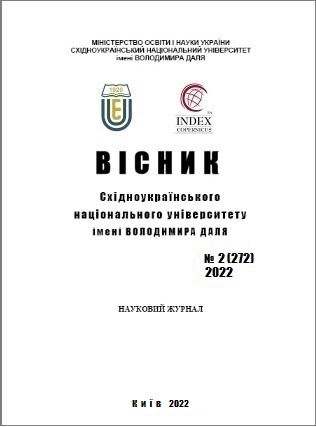Aналіз роботи терілок провального типу з вільнім перерізом до 25%
DOI:
https://doi.org/10.33216/1998-7927-2022-272-2-74-81Ключові слова:
отвір, параметр, вільний переріз, діаметр, тарілка провального типуАнотація
В статті розглянута робота тарілок провального типу з вільним перерізом до 25 %.На гідродинамічні характеристики тарілок провального типу найбільше впливає їх вільний переріз.Тарілки дозволяють використовувати їх при роботі з забрудненими середовищами, так як прохід пари і рідини, через отвори що чергується, забезпечує їм дію, що самоочищує. розглянути гідродинамічні характеристики газорідинного шару на тарілці провального типу на основі рівняння Бернуллі в трьох перерізах. Перше, на рівні плато тарілки, друге – на рівні Н ≈ 0,1 м від плато тарілки та третє – на виході з газорідинного шару. Було встановлено, що є три режими роботи тарілок провального типу. При низьких витратах газу спостерігається режим змочування, коли відбувається контакт газу з рідиною, яка затримується на тарілці. При подальшому збільшенні витрати газу розвивається барботажний режим, у якому газ проходить через рідину, як окремі бульбашки. Відбувається збільшення висоти піни за рахунок рівномірного потоку газу через отвори тарілки. Ще більш велике збільшення витрат газу та рідини призводить до розвитку пінного режиму. Відзначено, що на тарілках провального типу можна виокремити три режими роботи: режим однорідного барботажного шару;режим рухомого газоридинного шару;режим руйнування газоридинного шару.У колонних з невеликим діаметром D = 0,057 і 0,15 м і звичайним вільним перерізом (f < 0,25) газорідинний шар при швидкості, що перевищує wmax, починає різко збільшуватися до його виходу через верх колони.У колоні промислового розміру D = 2 м, при збільшенні швидкості газу вище wmax, через частину рідини на тарілці газ взагалі не барботується, а через іншу частину тарілки газ проходить з більшою швидкістю, ніж середня швидкість, розрахована на повний переріз колони.Показана особливість роботи таких масообмінних тарілок на відміну від тарілок з великим вільним перерізом >30 %. Робота тарілок з вільним перерізом до 25 %, пов’язана з параметром Т, що являє собою відношення суми периметрів всіх отворів плато тарілки до її діаметра.
Посилання
1. Garcia J.A., Fair J.R.Distillation sieve trays without downcomers. prediction of performance characteristics. Ind. Eng. Chem. Res. 2002.№ 41. P.1632-1640.
2. Kurella SwamyB.C. MeikapHydrodynamic characteristics of a three-stage dual-flow sieve plate scrubber.SouthAfricanJournalofChemicalEngineering.2017. № 23. P. 91-97.
3. Тараненко Г.В. Гидравлические и массообменные ха-рактеристики тарелок провального типа с различным диаметром отверстий: монография. Луганск: 2013. 175 с.
4. Касаткин А. Г., Дытнерский Ю. И., Попов Д. М. Гид-равлические закономерности процессов на барботажных тарелках провального типа Хим. пром. 1961, № 7, С. 482 – 491.
5. Васильев А. С, Талачев В. С., Павлов В. П., Плановский А. Н. Закономерности истечения струи газа в жидкость. ТОХТ. 1970, том ІV, № 5, С. 727 – 735.
6. Тараненко Г.В. Дослідження витікання газу з отвору в тарілці провального типу. Вісник Східноукраїнського національного університету імені Володимира Даля. 2021. № 1 (265).С. 124-127.
7. Taranenko G. Calculation of the lower operating limit of dual-flow plates with different geometrical characteristics. 2015. ScienceRise. Vol. 3, Issue 2 (8). – P. 67–73.
8. Тараненко Г.В. Гидродинамическое моделирование ре-жимов работы тарелок провального типа, установлен-ных в колоннах различного диаметра 2017. ScienceRise.Том 6, № 1(35) С. 34-38.
9. Sherwood T. K., Shipley G. H., Holloway F. A. L. Flooding Velocities in Packed Columns Industrial & Engineering Chemistry.1938. Vol. 30, Issue 7. P. 765–769.
10. Касаткин А. Г., Дытнерский Ю. И., Умаров С. У. К расчету колонн с провальными тарелками. Химическая промышленность.1958. № 3. С. 38–45.
11. Syeda S. R., Afacan A., Chuang K. T. A Fundamental Model for Prediction of Sieve Tray Efficiency. ChemicalEngineeringResearchandDesign. 2007. Vol. 85(A2), Issue 2. P. 269–277.

